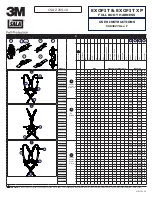
C-3 MONTAGGIO
DELL’AVVOLGIFIOCCO IN
TESTA D’ALBERO
•
Ricollegare il terminale dello strallo in testa
d’albero utilizzando allo scopo una drizza.
PERICOLO
PERICOLO DI FOLGORAZIONE
ATTENZIONE
AVVERTENZA
RISPETTA L'AMBIENTE
Non eseguire installazioni in testa d’albero in
caso di forte vento.
C-4 COLLEGAMENTO DELLO
STRALLO
PERICOLO
PERICOLO DI FOLGORAZIONE
ATTENZIONE
AVVERTENZA
RISPETTA L'AMBIENTE
Lo strallo da collegare deve essere di tipo
torsionale e già completo di redancia.
•
Per collegare lo strallo è necessario prima
togliere la candela (
B
), il Cunningham (
C
) e
la boccola (
D
).
•
Svitare tutte le viti (
E
) di collegamento tra
candela (
B
) e corpo macchina e sfilare il
blocco candela, Cunningham e boccola
prestando attenzione a non danneggiarli.
•
Far passare lo strallo all’interno della boccola
(
D
) e della candela (
B
). Se il foro della boccola
risultasse troppo stretto è possibile aprirla
svitando prima le viti (
F
) di collegamento
fra boccola e candela e poi le viti (
G
) che
uniscono i due semigusci.
•
Svitare il dado (
H
) dal tenditore (
A
) e sfilare
il perno (
I
).
•
Posizionare lo strallo al centro della forcella
del tenditore (
A
); reinserire il perno (
I
) nella
sua sede facendolo passare all’interno del
foro della redancia.
•
Riavvitare il dado (
H
) al perno (
I
) serrandolo
bene.
•
Rimontare la candela (
B
) con il Cunningham
(
C
) al corpo macchina riavvitando e serrando
bene le viti (
E
).
•
Se si è reso necessario smontare la boccola
(
D
), riunire i due semigusci e riavvitare
serrando bene le viti (
G
).
•
Rimontare la boccola (
D
) alla candela (
B
)
riavvitando e serrando bene tutte le viti (
F
).
•
Regolare la tensione dello strallo con il
cilindro.
PERICOLO
PERICOLO DI FOLGORAZIONE
ATTENZIONE
AVVERTENZA
RISPETTA L'AMBIENTE
Assicurarsi che, durante il lavoro, il pistone
tendi strallo non arrivi mai al termine della corsa
prevista del cilindro.
In questo modo, ci si assicura che, la tensione/
carico ovvero la pressione bar esercitata con
sistema idraulico di bordo, sia correttamente
erogata sullo strallo e non sul finecorsa corpo
cilindro evitando così errori di lettura da parte
degli eventuali sensori di pressione e di posizione.
C-3 HOW TO INSTALL THE
FURLER ONBOARD
• Connect the top of the stay to the mast head
using a halyard.
DANGER
DANGER OF ELECTROCUTION
CAUTION
WARNING
RESPECT THE ENVIRONMENT
Do not attempt to install the assembled system
in strong winds
C-4 HOW TO CONNECT THE
TURNBUCKLE
DANGER
DANGER OF ELECTROCUTION
CAUTION
WARNING
RESPECT THE ENVIRONMENT
Only a torsional stay complete with a thimble may
be connected.
• Before you connect the stay you need to take
off torque tube (
B
), Cunningham (
C
) and
bushing (
D
).
• Unscrew all screws (
E
) connecting torque
tube (
B
) to furling motorization. Let torque
tube, Cunningham and bushing slide paying
the outmost attention not to damage them.
• Allow for the stay to pass through bushing
(
D
) and torque tube (
B
). Should the hole in
the bushing be too narrow, you may open it
by uscrewing screws (
F
) connecting bushing
to torque tube first. Then you may unscrew
screws (
G
) that hold the two half shells
together.
• Unscrew nut (
H
) from tensioner (
A
) and take
off pin (
I
).
• Position the stay in the middle of the tensioner
fork (
A
); re-insert pin (
I
) in its slot. Make sure it
slides through the thimble hole as well.
• Unscrew nut (
H
) to pin (
I
) and tighten well.
• Re-assemble torque tube (
B
) and Cunningham
(
C
) to the furling motorization. Carefully screw
in and tighten all screws (
E
).
• If you had to disassemble bushing (
D
), put the
two half shells together. Then carefully screw
in and tighten all screws (
G
).
• Put bush (
D
) back into position on torque
tube (
B
). Then carefully screw in and tighten
all screws (
F
).
• Adjust the stay tension through the integrated
stay tensioning cylinder
DANGER
DANGER OF ELECTROCUTION
CAUTION
WARNING
RESPECT THE ENVIRONMENT
Pay the outmost attention that, during its
operation, the stay tensioning piston never
reaches the stroke end determined for the
cylinder.
This way, you will ensure that the tension / load,
or the pressure (Bar) delivered through the on-
board hydraulic system is correctly exerted on
the forestay and not on the cylinder body stroke
end, thus avoiding reading errors by any possible
pressure and/or position sensors fitted.
ISTRUZIONI DI MONTAGGIO E USO
INSTALLATION AND USE
C
13
um_cts_it-en_rev. 05/2022
I
F
D
G
B
H
B
A
D
C
E
E
F
G
G
A
Summary of Contents for GFSI CTS
Page 33: ...33 um_cts_it en_rev 05 2022 NOTE NOTE ...
Page 34: ...34 um_cts_it en_rev 05 2022 NOTE NOTE ...
Page 35: ......














































